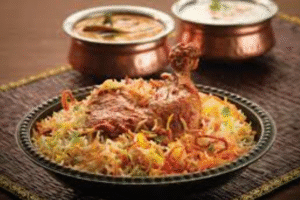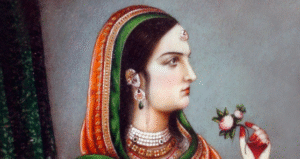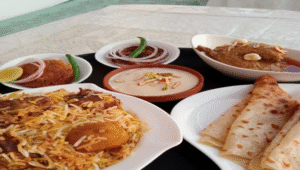How To Make Chicken Biryani
Chicken biryani is a flavour Indian rice dish featuring layered basmati rice, marinated chicken, and a blend of aromatic spices. It’s a popular dish in South Asia and beyond, often prepared for special occasions. Typically, the chicken is marinated in yogurt with spices, then layered with rice and other aromatics like fried onions and saffron before being slow-cooked to make the dish tender and flavourful. Characteristics of chicken biryani: Layered Cooking:
The layered cooking method of biryani involves layering rice and chicken and slow-cooking them to develop complex flavours. Aromatic Spices: The dish includes aromatics like saffron and fried onions in addition to a variety of spices like ginger, garlic, turmeric, red chili, cumin, and coriander. Cooking Slowly: The rice is cooked slowly, or “Dum ” so it can take in the flavours of the chicken and spices. This makes the rice tender and flavourful. Regional Variations:
While the core ingredients and method remain consistent, variations in spices, herbs, and cooking techniques can be found across different regions.
Serving:
A raita, or yogurt sauce, and other accompaniments like shawarma or biryani gravy are typically included with chicken biryani.
History of Chicken Biryani
The history of chicken biryani is fascinating because it combines Persian influence with Indian adaptation. The Mughals brought the dish to the Indian subcontinent, where it is believed to have originated as a pilaf dish in Persia. While chicken is now a popular protein, biryani traditionally featured mutton, and its popularity in India is largely attributed to the Mughals’ culinary contributions and the dish’s subsequent regional variations.
Here’s a more detailed look:

Origin and Introduction:
Iran’s influence:

The Persian dish “pilaf,” in which rice is cooked with meat and fragrant spices, is where the name “biryani” comes from. The Mughal Empire It is believed that the Mughals, who ruled India for centuries, introduced biryani to the subcontinent. King
Noor Jahan:

Some accounts credit Queen Noor Jahan, the wife of Emperor Jahangir, with introducing biryani to the Mughal court.
Development and Variations:
Regional Differences:
Biryani evolved into various regional styles, with Hyderabad, Awadh, and Kolkata being particularly known for their unique variations.
Hyderabadi Biryani:

Hyderabadi biryani, a prominent regional variation, is believed to have originated in the royal kitchen of Hyderabad and is known for its use of spices and the Dum cooking method.
Awadhi Biryani:

Lucknow’s Awadhi biryani is made by layering cooked meat and rice in a copper vessel inspired by the Nawabs of Awadh. Biryani with Chicken: Chicken became a popular protein choice, particularly in certain regions and for a broader audience, whereas mutton was traditionally preferred. Factors Contributing to Popularity:
Aroma and flavour:

The dish’s appeal is bolstered by its distinctive flavour and aroma, which are the result of aromatic spices and cooking techniques. Mughlai Influence:
The Mughals’ culinary traditions, including their emphasis on rich flavorous and royal dishes, played a significant role in biryani’s popularity. Biryani’s popularity grew even more as it evolved into a variety of regional variations, each with its own distinct characteristics. Cultural Importance: In India, biryani has emerged as a cultural icon as a symbol of a culinary tradition that is revered and enjoyed by a variety of communities.
:PROCESS OF CHIKEN BIRYANI:
🌟 Chicken Biryani Recipe (Serves 4)
📝 Ingredients
For Chicken Marinade:
-
500g chicken (bone-in preferred)
-
1 cup plain yogurt
-
1 tbsp ginger-garlic paste
-
1 tsp turmeric powder
-
1 tsp red chili powder
-
1 tsp garam masala
-
Salt to taste
-
Juice of half a lemon
For Rice:
-
2 cups basmati rice (soaked for 30 mins)
-
4 cups water
-
2-3 green cardamoms
-
4-5 cloves
-
1 bay leaf
-
1-inch cinnamon stick
-
Salt to taste
For Biryani:
-
2 large onions (thinly sliced)
-
2-3 tbsp oil or ghee
-
1/4 cup chopped mint leaves
-
1/4 cup chopped coriander leaves
-
A pinch of saffron soaked in 1/4 cup warm milk (optional)
-
1 tsp biryani masala (optional)
👨🍳 Instructions
-
Marinate the Chicken:
-
Mix all marinade ingredients and coat chicken well.
-
Cover and refrigerate for at least 1 hour (overnight is best).
-
-
Cook the Rice:
-
Boil water with spices and salt.
-
Add soaked rice and cook until 70% done (still firm).
-
Drain and set aside.
-
-
Fry the Onions:
-
In a heavy-bottomed pot, heat oil/ghee.
-
Fry sliced onions until golden and crispy. Set aside half for garnish.
-
-
Cook the Chicken:
-
In the same pot, add marinated chicken.
-
Cook on medium heat until chicken is 80% done and oil separates.
-
-
Layer the Biryani:
-
Turn off heat. Layer rice over the chicken.
-
Sprinkle fried onions, mint, coriander, and saffron milk.
-
Cover with a tight lid or dough-sealed.
-
Cook on low flame for 20–25 minutes (dum method).
-
-
Serve:
-
Gently mix before serving.
-
Serve hot with raita, salad, or boiled egg.
-

